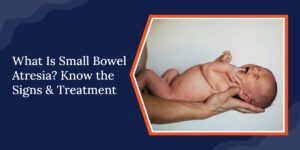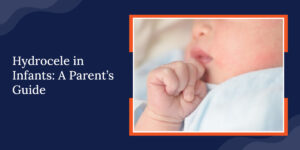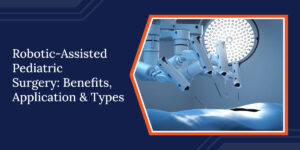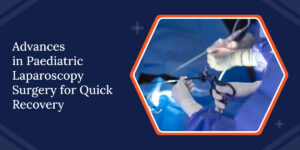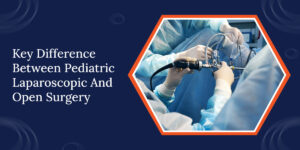A child may need to undergo surgery for a variety of reasons. This experience is almost always full of anxiety for the parents. Parents always want the most effective and least painful procedure for their child. Paediatric laparoscopic surgery is a modern procedure that offers such benefits. However, there are many questions and concerns surrounding it.
This blog will explain the key difference between paediatric laparoscopic and open surgery and when paediatric laparoscopic surgery is preferred over open surgery. We aim to provide you with all the information you need to make an informed decision for your child’s health.
A] What is Paediatric Laparoscopic Surgery?
Laparoscopic surgery (minimally invasive surgery) is a modern method of performing surgery using smaller incisions that are less painful and heal faster. Doctors insert a small video camera inside the incision to clearly see the organs on a monitor screen. The doctors operate using special instruments inserted through the incisions.
Due to the reduced risk factor and pain during the surgery, paediatric laparoscopic surgery is widely popular amongst doctors and parents alike. Paediatric laparoscopic surgery can be performed for operating on various parts of the body, including the stomach, gallbladder, liver, intestines, appendix, colon, kidney, spleen, and ovaries. Unlike a surgeon for adults who usually specialises in a single set of organs, a paediatric laparoscopic surgeon in Dubai is trained to operate on various organs in the child’s body.
Choose the Best Surgery for Your Child’s Health—Learn More!
B] What is Traditional Paediatric Open Surgery?
Traditionally, children are operated using open surgery for conditions affecting the brain, spine, heart, abdomen, and other areas. Open surgery is done by creating a large incision, giving the surgeon direct access to the organs they will be operating on. Paediatric surgeons can directly see the organs and other inner tissues, offering more control and manoeuvrability.
Also Read: Top 8 Benefits of Choosing a Paediatric Surgeon for Your Child
The larger incision takes more time to heal and elevates the risk of complications. Nowadays, open surgery is often not suggested for paediatric surgeries. Open surgery can also cause trauma to skin tissues, causing scars that never heal. Patients may also have to take complete bed rest for a few weeks after an open surgery to fully recover.
C] Comparing Paediatric Laparoscopic And Open Surgery Techniques
| Paediatric Laparoscopic Surgery | Traditional Open Surgery | |
| Number of Incisions and Their Size | The incision size in paediatric laparoscopic surgery is much smaller than in traditional open surgery. The surgery often requires around three to four incisions that are 5-10 mm long. The number of incisions is based on the type of procedure and equipment used. | As the name suggests, open surgery opens up the chest or abdomen cavity during the respective procedure. It involves only a single incision that is several centimetres long. The typical size of the incision varies depending on the complexity of the procedure. |
| Post Operative Pain | Children reportedly feel less pain after a paediatric laparoscopic surgery. As the surrounding organs, muscles, and tissues are minimally disturbed, they are often not sore or in pain. Hence, the need for pain suppressants is greatly reduced. | Children and infants experience high pain levels after a traditional open surgery. Pain and swelling are very common due to muscle and tissue disruption. Children are often crying after the effects of anaesthesia wear off and must be given painkillers. |
| Recovery Time | Recovery is fast due to smaller incisions and less muscle disruption. Children can often go back to their regular life within a week of surgery, depending on the type of surgery. | Recovery is generally slower and can take up to a couple of months to completely heal. The scars on the skin may also take time to completely heal and become one with the skin. |
| Risk Of Complications | Bleeding from the incision or the abdominal cavity and temporary fluid leakage from surgical wounds are common complications. However, there is absolutely no risk of any life-threatening complications. According to a study, complications in paediatric laparoscopic surgery only occurred in 5.4% of cases in data from more than 5400 laparoscopic surgical procedures. | Open surgery has a high risk of bleeding, stitches reopening, and infections. The larger incisions also cause trauma to the nervous system, leading to a host of minor problems like dizziness, constipation, and gas, depending on the surgery. |
| Surgical Precision | Paediatric laparoscopic surgery uses high-definition cameras to visualise the organs inside the body. Doctors use precise tools to navigate inside the patient’s body. | The organs are directly accessible to the surgeon leading to better handling of larger parts of the organ. However, it is less precise for smaller operations. |
| Cost Of Treatment | Laparoscopic treatment is usually more expensive than open surgery due to the need for advanced equipment. | Open surgery is generally less expensive as it does not need any special equipment. |
| Hospital Stay | Paediatric patients who undergo laparoscopic surgery may be discharged after 1-2 days. | Open surgeries have higher chances of developing complications. Hence, doctors might ask you to stay longer, often a week or more. The length of the stay depends on the complexity of the surgery. |
Choose the Best Surgery for Your Child’s Health—Learn More!
D] When is Paediatric Laparoscopic Surgery Preferred Over Open Surgery?
Paediatric laparoscopic surgery causes lower blood loss and has a lower risk of complications like infections, wound dehiscence, and trauma. As a result, paediatric laparoscopic surgery is the preferred choice in most cases. However, laparoscopic surgery is not suggested for patients with medical conditions like heart disease. Consult your paediatric surgeon in Dubai to figure out which method works best for your child.
Conclusion
Laparoscopy and open surgery are both widely used and valid means of treatment for children. Each technique has its own set of pros and cons. However, the advantages of laparoscopic surgery in children over open surgery cannot be ignored, including faster recovery, less pain, smaller incisions, and lower risk of complications.
A trusted paediatric surgeon will be able to help you choose the best course of action for your child’s health and well-being. If you are looking for a trusted and reputed paediatric surgeon in Dubai, contact our clinic today!

Dr. Bhushanrao Jadhav
Dr. Bhushanrao Jadhav is a highly skilled Pediatric Surgeon and Urologist specialising in minimally invasive and robotic surgeries for children. With advanced training from leading institutions in the UK, India and USA, he brings expertise in treating complex genitourinary conditions and neonatal surgical ailments. Driven by compassion and innovation, Dr. Jadhav has pioneered pediatric robotic surgery programs in Pune, India, ensuring world-class care tailored to children’s unique needs.






